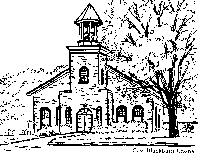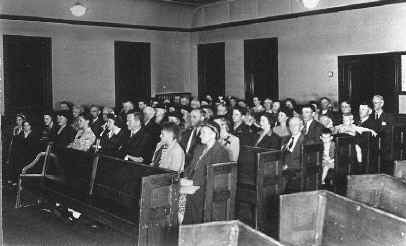Chartiers Hill
United Presbyterian Church
2230 Washington Road
Canonsburg, PA 15317
724-746-1330
Presbytery
Home Page -- E-mail
Donald C. Austin Minister



Hill Church 1938
Front Wall Collapsed on Oct. 24, 2002 following the removal of the bell tower as
part of a renovation project.
Building
was rededicated on March 7, 2004
Prayer and hard work bring church back from collapse
BY DAVID PENN, Staff writer Observer-Reporter.com
After 16 months of renovation work, and a considerable supplement of prayer, the congregation of Chartiers Hill United Presbyterian Church may move back into its place of worship next month.
Standing along Route 19 in North Strabane Township, Hill Church is among the oldest churches in the area. Work to upgrade plumbing and make the 160-year-old building handicapped-accessible began in 2002, but workers ran into a major stumbling block in October of that year, when a brick wall at the front of the church collapsed. Some wondered whether the church could be preserved at all, and renovations initially estimated to take about six months stretched over more than a year.
"You could say it's been a long haul," said Nancy Magera, a member of the church's rededication committee.
No firm dates are set, but the church has planned a dedication ceremony along with open house days for the community to see the work that has been done. Employees of Rhodes Carpet & Installation were preparing to lay carpet in the nave Tuesday, but that was only one finishing touch on a major structural overhaul.
In October 2002, shortly after a new roof was installed, a Butler demolition company removed a bell tower that had stood at the front of the building for more than 90 years. Deemed the part of the church with the least historical value, the bell tower was dismantled to make way for a new entryway that could accommodate wheelchairs and house handicapped-accessible restrooms.
The same week, a wall that had stood behind the tower, the rear wall of the sanctuary, toppled. The bell tower apparently had provided it critical support; a foundation beneath the wall ran only three feet deep. Planners waited nervously through the winter for the ground to thaw before they could bolster the foundation and rebuild the wall.
In the meantime, the congregation was meeting in the basement of a building next to the church. Christmas services during the past two years have been held at the Candlelight Room in Washington, and attendance has dipped during construction. The Rev. Donald C. Austin, pastor of the church, said the experience has been trying, but ultimately it may make the congregation stronger.
Austin said questions of whether the building could be preserved and whether the church members would be able to afford mounting costs were a source of constant concern. "Most important was the spiritual aspect, whether we could maintain this building and all it has meant," he said.
The red-brick church dates from1840, when it replaced a previous building, probably made of wood, that had served as a house of worship since the 1770s.
Bricks for the construction were fired at the site, and the foundation that failed the front wall 14 months ago was made of hand-hewn stone. A churchyard contains the remains of some of the earliest settlers of the region.
According to Austin, the bell tower was added early in the 20th century under the direction of Murray C. Reiter, a pastor of
the church who instituted several projects, including the construction of classrooms. The decision to replace the tower drew some criticism, but Austin said the changes were necessary in light of the property's old, unreliable septic system and cramped stairs and entrances that made it difficult for elderly members to enter the church. A plan to move forward with the renovations
was approved in a vote of the congregation.
The fallen wall has long since been replaced, and the church now does exhibit a more modern style, at least on the inside. An elevator allows for easy access to a community space in the basement, and grinder pumps have been installed to send waste water into the municipal sewer system.
The exterior remains red brick, and the new tower matches the old building pretty closely.
"People tell me, unless you grew up around here and knew what the church used to look like, you'd never guess it wasn't always like this," said Austin.
A chandelier donated to the church hangs above the nave, at the center of a sprawling geometric design painted on the ceiling. The decoration on the ceiling also is a recent addition, inspired by a photograph nearly a hundred years old.
The photograph, Austin said, pictures a gas-fueled chandelier and a portion of the ceiling design. Also pictured is the Rev. Reiter, now hopefully appeased for the demolition of his bell tower.
On the fourth Sabbath of August 1775, the Rev. John McMillan, later to be known as "The Apostle of Presbyterianism in the West," preached to a gathering of neighbors at the home of John McDowell, not far from the site of the present church building. On that day the roots of the "Hill'' Church began to grow.
Dr. McMillan was called as pastor by the congregations of Chartiers and Pigeon Creek in 1776. He served these two churches for 19 years.
The first church building was completed on the approximate site in 1778. A
stone structure was built in 1800, remodeled in 1832. The belfry and vestibule were built
between the years of 1907 and 1914. The Christian Education Building was built in 1957.
See pictures at: Chartiers
Hill United Presbyterian Church & Cemetery
Charter members of the "Hill" Church were mostly of Scotch- Irish descent . The Church's membership has never exceeded 400 at any time.
Sixteen ministers have served as pastors. Aside from Rev. McMillan, one other pastor is of historical note. Rev. Joseph R. Wilson, father of President Woodrow Wilson, ministered from 1849 until 1851.
Rev. Lee E Schaeffer* began his ministry here in 1930 and served untill 1938. At that time he and his new wife, Catherine Cochran Schaeffer, lived in the manse across the road from the church and was paid in chickens and fresh baked bread. During this time, the basement rooms were excavated under the church.
Chartiers Hill Church is a member of the Washington Presbytery, Synod of the Trinity and General Assembly of the Presbyterian Church (U.S.A.)
“How It Was Back Then.” In those early days, the church was often the center of our
social as well as our spiritual life. In my case, it was the historic Chartiers Hill
Presbyterian Church, thought to be the oldest church west of the Allegheny Mountains. My
grandfather lived close to the church in a little white frame house that had been the
parsonage when President Woodrow Wilson’s father was the pastor of the church and
lived in this same little house. |
Jesus said: "I am the way, and the truth) and the light." Beyond
the right hand of Christian fellowship, we offer to you the good news' of God's gracious
presence an history and individual lives. May the spirit of the risen Christ fill you with
hope and peace.
Donald C. Austin Minister
CHURCH OFFICE
2230 Washington Road
Canonsburg, PA 15317
Phone: 4l2-746-1330
HOURS: 9 a.m. - 12 noon Monday - Friday
Presbytery Home
Page -- E-mail
SCHEDULE
Church School - 9:30 a.m.
Worship Services- 8:30 a.m. & 11 a.m.
Summer Schedule ( July & August) Worship - 10:00 a.m.
![]()